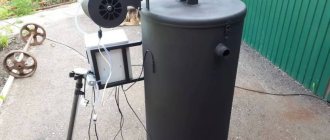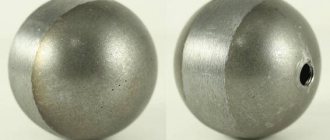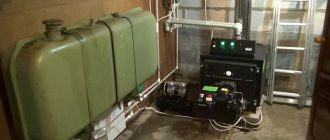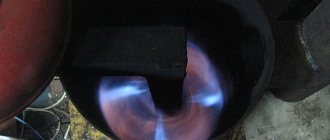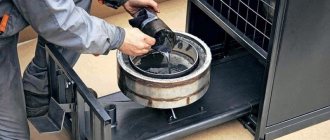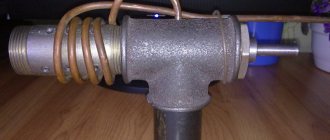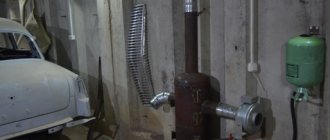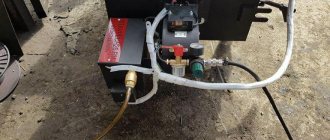oil used for cooling DOES NOT BURN :))) there is a concept of “flash point”, but it does not apply to normal conditions; the use of oil in cooling systems is stopped only by one circumstance - oil is EXPENSIVE for reference - good oil can be DRINKED without any harm to the body (probably just disgusting  )
)
In the garage, we use oil as a heating medium for the entire system with an expansion tank, etc. it took 300-350 liters
I couldn’t set fire to the oil itself; wood watered with it burns very poorly
the only negative is the thickening, but when warmed up the oil becomes liquid again very quickly
What doesn’t burn, even transformer oil, is fantastic-)))) It burns and putting it out is a whole problem, you need to sprinkle sand in such a thick layer that you’ll be tortured by swinging a shovel-)))) All containers with any oil have a symbol “flammable”, just for some the ignition temperature is not higher than for paper, but, under certain conditions, vapors can form, which not only ignite easily, but also explode. But, however, those who do not agree with this can add oil; transformer oil is not difficult to obtain. “To ensure effective heat removal, transformer oils must have the lowest viscosity at a flash point of at least 95, 125, 135 and 150 ° C for different brands.” – this is from data from oil manufacturers (paper, if I remember correctly, ignites at a temperature of about 200 degrees Celsius)
“The flash point is the temperature of oil heated in a crucible, at which its vapor forms a mixture with air that ignites when a flame is brought to it. The flash occurs so quickly that the oil does not have time to warm up and ignite. The flash point of transformer oil should not be lower than 135° C. If you heat the oil above the flash point, then there comes a moment when when a flame is brought to the oil, it ignites. The temperature at which the oil ignites and burns for at least 5 seconds is called the ignition temperature of the oil. The temperature at which combustion occurs in a closed crucible, in the presence of air, without the application of a flame, is called the auto-ignition temperature. For transformer oil it is 350-400 ° C.” - this is from the reference book. “Measures to extend the life of the oil are:
1) protecting the oil from contact with outside air by installing expanders with filters that absorb oxygen and water, as well as displacing air from the oil; 2) reduction of oil overheating under operating conditions; 3) regular cleaning of water and sludge; 4) use of continuous oil filtration to reduce acidity; 5) increasing oil stability by introducing antioxidants.” – this is what needs to be ensured during operation.
However, you can look at this “The class of organofluorine liquids is very interesting. In foreign literature they are called perfluorocarbons. In fact, this is the equivalent of ordinary organic liquids, but instead of a hydrogen atom, there is a fluorine atom everywhere. For example, there are analogues to organic compounds, such as pentane C5H12 - perfluoropentane C5F12, hexane C6H14 - perfluorohexane C6F14, triethyl(propyl, butyl)amine - perfluorotriethyl(propyl, butyl)amine, etc. There is even perfluorotransformer oil. (Unlike real transformer oil, perfluorotransformer oil is a solid under normal conditions and is used as a frost-resistant lubricant.) The presence of fluorine in place of hydrogen means that the substance is completely oxidized, because fluorine is the strongest oxidizing agent, stronger than oxygen. Therefore, fluorocarbon liquids are inert with respect to any influences, incl. stable under the influence of electric field and temperature. Since they do not interact with anything, they do not dissolve oils, rubber, water, etc. The high performance of fluorocarbon fluids is important for applications. Replacing the H atom with an F atom leads to new properties and new possibilities:
Heating is important
The issue of heating arises even during the design of a new house. Sometimes it appears when the operating mode changes. So, for example, a person could buy himself a country house, which the previous owners visited only in warm weather. Now he intends to visit it in late autumn and winter. What to do? Shouldn't you stay in a cold room? The answer is obvious - heating. It is important to choose which one and with what coolant. It depends on many factors.
Most people try to use water in their system, since it is the cheapest and most energy-intensive coolant. Moreover, if the temperature drops below zero, it will freeze. As a result, the system will have to be heated, and, at best, some burst pipes will have to be welded. At worst, you need to change the entire system, including the boiler. This situation is not only unpleasant, but also costly.
Therefore, in winter, special additives are used for water to prevent freezing. They come in different varieties, ranging from liquids with mineral salt to alcoholic ones. Each has its own positive and negative qualities. But still, none of them can be called ideal. It is in this regard that many people think not about what to add to the water, but what to replace it with.
How to choose a coolant
The rating of coolants for open and closed heating systems contains products that prevent pipes from defrosting, as well as prevent scale formation, bacterial growth and corrosion of metal joints. But when choosing antifreeze for the boiler and radiators, it is important to pay attention to some parameters of the substance:
- The basis.
The packaging always indicates which product is the main one in the composition. The most antifreeze is ethylene glycol. It has increased fluidity, so sealing joints must be especially careful. But there are never any problems with it in terms of circulation. But this coolant is also the most toxic. A medium-priced and relatively new type is glycerin, which is more gentle and harmless, but requires replacing conventional gaskets with Teflon ones. The most expensive is propylene glycol, which is chemically neutral and resistant to overheating. A separate substance is oil, which has low antifreeze properties, but allows it to be heated to higher temperatures. - Crystallization point
. This is the number of degrees below zero, after which the fluidity of the product is lost. The indicator varies from -15 to -65 degrees, which is important to consider when choosing a coolant for use in heating systems in various regions with cold and temperate climates. - Boiling point.
Indicates when antifreeze begins to foam. For some, this occurs after 70 degrees. The maximum indicator is 115º C. The later the liquid boils during overheating, the longer it will retain its fluidity, the effectiveness of additives and will continue to perform its main functions - transfer heat. - Possibility of dilution with water
. Some substances for heating systems can only be used in their pure form, while others can be diluted with ordinary water according to the parts ratio table, depending on the winter temperature in the region. The second option is more economically beneficial, since it allows you to fill the volume of the system with less antifreeze, and add the rest with free water. - Life time
. Each coolant indicates a safe service life guaranteed by the manufacturer. During this period, the product will be gentle on seals and metal, and will also meet the specified crystallization and boiling characteristics. Some fluids last 4-5 years, others up to 10, which affects heating maintenance costs.
Advantages
Used oil in the heating system has many advantages:
- In winter, the liquid will not freeze. Unless the temperature in the house drops to -35 degrees Celsius. Agree, this is unlikely to happen.
- It doesn’t matter how long the negative temperature lasts, it does not affect the oil in any way. You can turn on the boiler and start heating the room at any time.
- Low volatility due to the structure.
- There is no need to additionally pour in any additives to prevent the coolant from freezing.
- The oil has high anti-corrosion properties. Therefore, there is no need to flush the system frequently.
- Has high thermal stability.
Antifreeze for a country house
With the arrival of cold weather, summer residents solve the problem: should they change the water in the heating system to an antifreeze liquid or not? And which one - prescribed by the manufacturer or any other? And also: is it possible to fill in car antifreeze, transformer oil or ethyl alcohol? In general, they save the dacha from possible freezing of the heating when you rarely have to go outside the city.
— In modern dacha heating systems, you can use both water and antifreeze. The choice depends on specific conditions,” says Alexander Milov, head of a company that selects equipment for heating and water supply. — But it should be taken into account that in Russia electricity or gas is turned off often and for a long time. Heating water can freeze and burst pipes. Therefore, it is better to fill in a low-freezing liquid - antifreeze.
Antifreezes are also preferable because in most regions of Russia the water is hard and contains a large amount of salts, foreign inclusions and additives. As a result, during operation, scale, sediment, and corrosion quickly form in the heating system. Pipes and equipment have to be replaced every five to seven years. It should also be taken into account that water begins to boil already at 96-98 degrees, accelerating negative processes in the system, while antifreezes last at 160-180 degrees. However, if antifreeze reaches such temperatures (this is possible in case of abnormal heating operation), it will lose its properties due to thermal decomposition. The liquid acquires a characteristic unpleasant odor. Therefore, reliable circulation must be ensured for antifreeze.
What experts do not recommend using for heating is transformer oil, car antifreeze or ethyl alcohol. “They create unpleasant odors and contain substances harmful to breathing. In addition, the liquid must be fireproof,” says Vadim Pogorelov, head of the certification laboratory.
Most antifreezes are based on ethylene glycol. Thanks to it, the liquid based on it does not freeze at minus 65 degrees. But a mixture of ethylene glycol and water is even more corrosive than just water, so additives are added to antifreezes to prevent the appearance of rust, and at the same time the formation of foam and scale. Since all antifreezes are essentially the same (they differ only in the additive package), experts say that any antifreeze, including domestic ones, can be used in heating systems. Of the Russian brands, the most popular are Dixis, Hot Blood, Nord, Teply Dom and some others. However, when giving priority to domestic antifreezes, it should be borne in mind that among them there are many counterfeits and low-quality liquids. “Unfortunately, not all Russian antifreezes comply with GOST, and this is the cause of many problems,” says Vadim Pogorelov. — Increased foaming leads to “airing” of the system and reduced heat transfer. Heat exchangers often become clogged with corrosion products, and build-up forms on the heating elements. Russian antifreezes, as a rule, do not work well at high temperatures.
As for imported liquids, they, as a rule, are not designed for temperatures below minus 25-30 degrees. In addition, they often delaminate when diluted with hard water. Experts advise using water with a hardness of no higher than 7 units. Among the imported ones, the most famous brands are Antifrogen N, Inibahel, Feetherm.
Flaws
Despite the obvious advantages of this type of coolant, there are still a number of disadvantages:
- The need for filtration before injecting into the system. The fact is that usually the oil is a mixture of many oils of different brands and viscosity. In addition, it contains third-party components in the form of dirt and metal. The process of cleaning a considerable volume can cost a large sum.
- Availability of the required quantity. At the moment, there are no companies that are engaged in the targeted collection and purification of oil for future infusion into heating systems. Therefore, finding a sufficient amount of the desired consistency will be problematic.
- High fire hazard. In the event of a leak, there is a risk of fire. True, for this the liquid must come into direct contact with an open source of fire.
- It is not permissible to use a boiler with direct heating.
- Replacing all rubber gaskets and connectors with oil-resistant ones, which will be more difficult to find, since conventional heating systems are not equipped with them. In addition, their purchase can cost a large sum.
Conclusion
Now you know what heating systems are based on boilers running on waste oil. Moreover, you could get acquainted with general information about the profitability of using such systems.
All that remains is to consider the prospect of using this equipment in your country house and make the appropriate choice, which the video in this article will certainly help you with.
Heating is an important issue that every home or cottage owner faces. In addition to choosing equipment, you need to decide on the heating fluid. More and more people are thinking about using oil rather than water for their home heating system. There are many opinions regarding this issue, which we will try to understand.
Peculiarities
Before pouring used oil into the system, it is important to check many nuances that will affect the work and comfort of residents in the future.
So, it is known that this coolant is fluid, even in the cold. But for conventional heating this is not enough. Warm and cooled oil have significantly different viscosities. Therefore, the pipes in the system must have the same diameter. And sometimes on return bends you can make it larger. The fact is that the boiler itself heats up quickly, but does not have time to push the oil through. In this case, even boiling is possible.
It is also important to think about the size of the expansion tank in advance. In aqueous systems, 10% of the total liquid volume is usually taken. With oil, things are a little more complicated, because when heated, it expands more than H2O. Despite this, the level in the system still needs to be checked from time to time and topped up if necessary. In such designs, it is recommended to install tanks measuring 30% of the total volume.
A particularly important condition in the matter of heating a house with used and already purified oil is tightness. In most cases, it is not possible to completely avoid leaks the first time. It is considered ideal to apply a new weld in such places, since gaskets and similar elements do not solve the situation. After this, the system starts up and is checked for complete tightness - small drops appear in places where there are even microscopic holes. In this case, it is advisable to drain all the oil and digest the problem areas. In this case, the procedure must be repeated until the system is completely corrected.
It is imperative to pay attention to all connecting threads. It is very important that they are of high quality, especially when serving. Otherwise, small drops may appear on them when heated. And sometimes the connection will even leak. At the same time, it will be difficult to seal such a joint. You can immediately say that it will not be possible to solve the problem with tow or fulente. In some cases, specialized sealants that can withstand temperatures up to 400 degrees help.
Generally speaking, the use of oil in the heating system allows you to leave the room for a long time in any weather. And there is no need to worry about her hypothermia. In addition, with the help of this coolant you can heat batteries to high temperatures without fear of system failure. But, as with everything, there are positive and negative sides.
Author: SvTok, October 17, 2016 in Other
Rating of the best coolants
Having seen the key parameters for choosing a product, let’s move on to the rating of coolants based on the characteristics and user reviews. This will help you find out in advance the pros and cons of antifreeze for heating in a house, country house or enterprise, and choose the best one for specific operating conditions.
DIXIS-65
A universal tool for working with gas and electric boilers of any type of installation. Optimally transfers heat at ambient temperatures from -65 to +95º C. Suitable for heating with pipes made of cast iron, copper, aluminum, brass. Does not damage solder joints or harm plastic pipes and containers. Along with the product, a sticker for the boiler is provided, which contains fields for recording the date of refueling, volume and other important details, which will be very useful years later when servicing the heating.
Our experts awarded this coolant first place in the ranking due to its high crystallization temperature of -66 degrees. This is the best product for heating systems in the Far North and other cold regions, which will withstand severe frosts and keep pipes and radiators intact. If used in areas where the winter temperature does not drop below -20º C, antifreeze can be diluted with water in a 1:1 ratio, which will significantly save money.
Advantages
- fireproof;
- the highest antifreeze rate;
- guaranteed service life 5 years;
- protection of the container from unauthorized opening.
Flaws
- heat capacity is 10% less than that of water;
- strong viscosity;
- not suitable for galvanized pipes;
- cannot be poured into boilers with an electrode operating principle.
Warm House Eco
This is a domestic coolant based on propylene glycol, which is supplemented with a pigment additive to give it a green color to make it easier to detect leaks. Available in containers of 10 and 20 kg with convenient handles for transportation. The product is fireproof and has been tested, therefore it is accompanied by a certificate and is designed for widespread use in heating and air conditioning systems. The service life of the substance is 5 years, after which it retains all its antifreeze properties, but loses the package of additives that prevent corrosion. Users in their reviews share that if the heat exchanger in the boiler is copper and the pipes are plastic, then it can be used for up to 10 years.
In our opinion, the coolant should be included in the rating due to its elevated boiling point of 106º C, which is 11 degrees higher than most products. This is useful if the system frequently overheats, especially if it is rarely looked after. The thermal destruction point of the product is 170º C, so antifreeze is not in danger.
Advantages
- does not destroy flax tow;
- can be used with sealants;
- does not expand when frozen, but turns into jelly;
- the vapors are harmless to humans.
Flaws
- when used with galvanized communications, it produces sediment;
- not for electrolysis boilers;
- high fluidity when heated requires careful sealing and preliminary crimping;
- you need a powerful circulation pump.
THERMAGENT-65
The product is manufactured in Russia, but from raw materials imported from Germany. The production uses a special technology called Organic Acid Technology. But organic additives do not contain amines and other harmful substances. The coolant is compatible with boilers operating on liquid fuel, gas and electricity. Judging by the reviews, the liquid does not harm rubber gaskets, sealants and paranitis. The manufacturer has added anti-foam and antibacterial additives to the composition, so the system will remain clean and with high permeability.
Our experts included the coolant in the rating, because in addition to a very low freezing point of -65º C, it has a long service life. The liquid retains its anti-corrosion properties for up to 10 years, and can be used for up to 20 seasons continuously, without losing its freezing resistance characteristics. This is beneficial in terms of system maintenance costs and does not require frequent intervention.
Reviews of domestic exhaust boilers with a water circuit: advantages and disadvantages
| Advantages | Flaws |
| Availability and symbolic cost of fuel | High initial cost of boilers - almost all models cost more than 100 thousand rubles. |
| Simplicity and reliability - the trouble-free service life of boilers during testing is comparable to gas or diesel analogues, but, of course, depends on the manufacturer | The need for a separate room for the boiler room |
| Environmental friendliness - when the boiler operates correctly, the fuel is completely burned, releasing only harmless nitrogen and carbon dioxide | The need for quality ventilation |
| Simplicity of installation and connection - installation of the boiler does not require a permit; it is not necessary to organize large areas for storing fuel | High operating noise, however, according to reviews from owners, the boiler is not audible even through the relatively thin walls of the boiler room |
| Autonomy - classic models do not require human intervention and can work for months (except for the need for regular cleaning) | The need for regular cleaning (every 24 hours) of more budget vertical models |
| On average, lower (3-7%) efficiency than that of gas or diesel analogues (however, this is a barely noticeable drawback due to the low cost of fuel) | |
| Lack of double-circuit and wall-mounted models | |
| Automation of inexpensive models has rather limited functionality |

